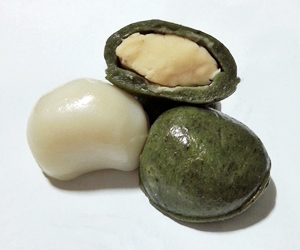Gaepi-tteok facts for kids
 |
|
| Alternative names | Baram-tteok |
|---|---|
| Type | Tteok |
| Place of origin | Korea |
| Associated national cuisine | Korean cuisine |
| Main ingredients | Rice flour, white adzuki bean paste |
| Korean name | |
| Hangul |
개피떡
|
|---|---|
| Revised Romanization | gaepi-tteok |
| McCune–Reischauer | kaep'i-ttŏk |
| IPA | [pa.ɾam.t͈ʌk̚] |
| Hangul |
바람떡
|
| Revised Romanization | baram-tteok |
| McCune–Reischauer | param-ttŏk |
| IPA | [pa.ɾam.t͈ʌk̚] |
Gaepi-tteok (개피떡) or baram-tteok (바람떡) is a special kind of tteok. Tteok is a popular rice cake from Korea. This yummy treat is shaped like a half-moon. It is made from rice flour. Inside, it has a sweet filling, usually white adzuki bean paste.
How to Make Gaepi-tteok
Making Gaepi-tteok involves a few fun steps. First, non-glutinous rice flour is steamed. This happens in a special Korean steamer called a siru. After steaming, the soft rice flour is pounded. This is done in a large mortar, known as a jeolgu. Pounding turns the steamed flour into a smooth dough.
Next, the dough is cut into small pieces. Each piece is rolled out flat and round. Then, a sweet filling is placed in the center. This filling is called geopipat-so. It is made from adzuki beans, often the black kind. The beans are husked, steamed, and seasoned with a little salt. After filling, the dough is folded into a half-moon shape. The edges are carefully sealed.
To keep the tteok from sticking together, Sesame oil is brushed on each one. This also gives them a nice shine and a bit of flavor.
Colorful Gaepi-tteok Varieties
Gaepi-tteok can come in different colors! These colors come from natural ingredients. For example, to make a green dough, Korean mugwort is used. It is pounded together with the steamed rice flour.
In a place called Gangwon Province, they use something else for green tteok. They pound deltoid synurus with the rice flour. This also makes a lovely green dough.
If you see pink Gaepi-tteok, it's made using a part of the Korean red pine tree. This part is called the endodermis. It gives the dough a pretty pink color.
Sometimes, the filling inside Gaepi-tteok can be different too. Many people, especially in Korean communities in places like Los Angeles, California, use a sweet mung bean paste instead. This gives the tteok a slightly different taste.

